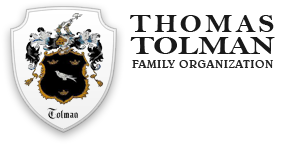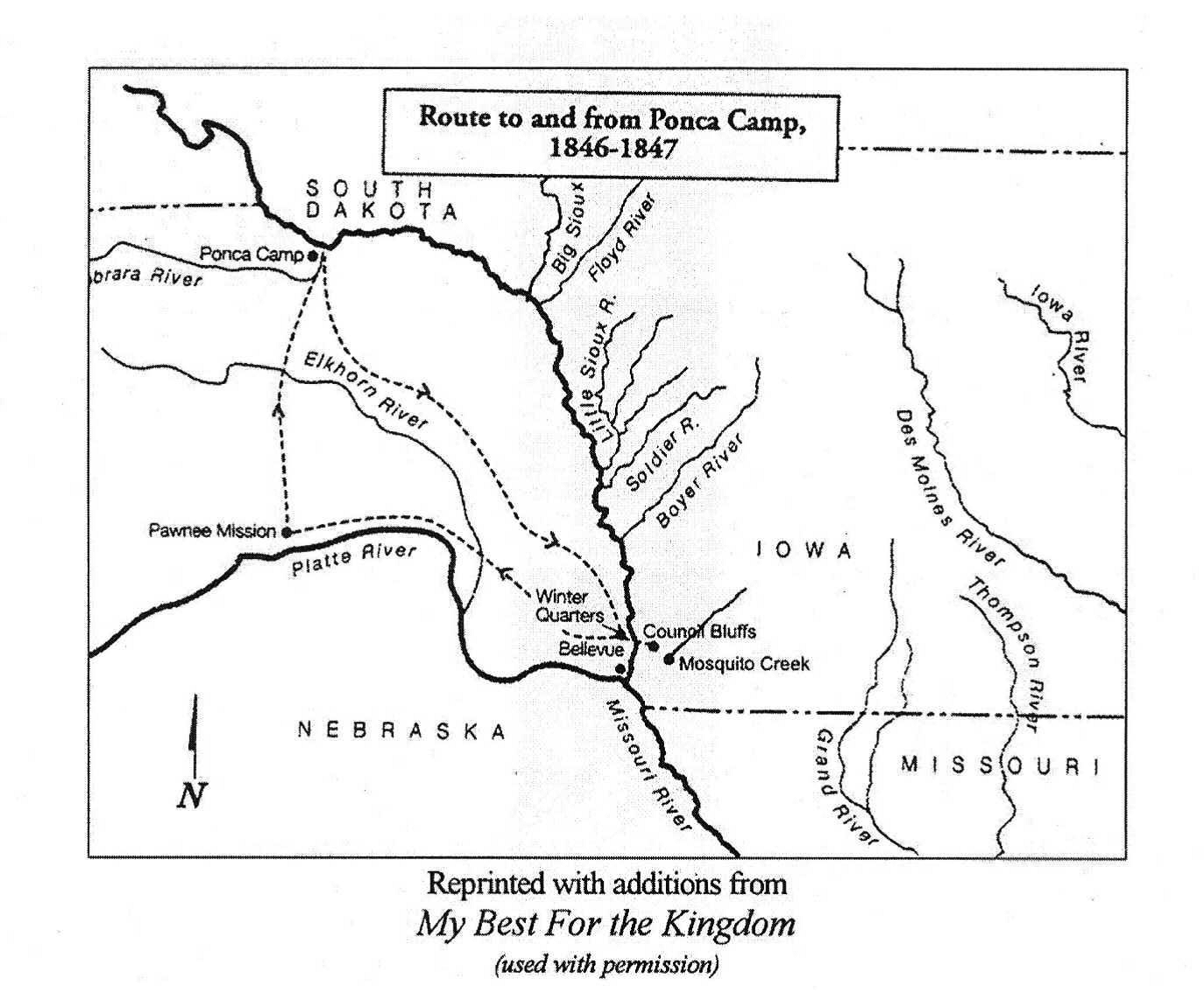(An account written by John Odell Tolman about Judson Tolman and Joseph Holbrook and their families.)
In September, 2002, my wife and I spent four glorious days in Nauvoo soaking in all that the restoration of the City of Joseph has to offer with the highlight of viewing and attending the all-inspiring Nauvoo Temple.
Next, we traveled to Church History sites in Missouri and then on to the Winter Quarters Temple and Visitors Center in Omaha, Nebraska. In Joseph Holbrook’s History, he records that they wintered in 1846-47 with George Miller’s Pioneer Company among the Ponca Indians near the mouth of the Running Water River. I had often wondered where that camp was located, and I was excited to find several books in a library at the Winter Quarters Visitors Center that unfolded a great deal of information on the subject. I discovered that the Running Water River is the same as the Niobrara River (Indian name) which flows south and then west from the Missouri River that borders Nebraska and South Dakota near the town of Niobrara, Nebraska. This was also the main encampment for nearly 2,000 Ponca Indians who were friendly to the Mormon Pioneers at this time.
On June 22, 1846, Joseph Holbrook and Judson Tolman and families reached the Missouri River, where Brigham Young invited them to join his company. They crossed the Missouri on the 7th of July with the intention to continue the journey west but were delayed due to the government’s request for the volunteers and the organization of the Mormon Battalion. Brigham Young’s company, consisting of 230 people with 71 wagons started west July 21, 1846, without their leader who remained at the Missouri River, planning to join them later. Early in August, this company caught up with and joined Bishop George Miller’s company who had pushed ahead about 125 miles west of Winter Quarters and were camped at an abandoned Pawnee Indian mission northeast of Grand Island. On August 7, Newell Knight brought a letter from Brigham Young and the Twelve containing instructions not to go further west but to leave some of the people at the Pawnee Mission and take the remainder to Grand Island for the winter. The letter also stated George Miller was to be the President, with 11 other brethren, including Joseph Holbrook as High Councilors.
Meanwhile, several Ponca Indians, including their Chief, came to the Pawnee Mission and warned Bishop Miller that the Mormon livestock would eat the peavines which the Pawnee used for their horses during the early winter. Considering this situation unsafe, the Ponca invited Bishop Miller to winter with them. The Miller Company accepted the offer and with 175 wagons journeyed north about 150 miles to the mouth of the Niobrara River arriving near the Ponca Village on August 23rd. While at the Ponca settlement, George Miller in conversation with several explorers and trappers, became convinced that the route the saints should take to the Great Basin was to follow the Niobrara River across Northern Nebraska into Wyoming Territory and establish a way station (like Mt. Pisgah) on the Yellowstone about 5 or 6 days travel north of Ft. Laramie. Under Bishop Miller’s direction, Joseph Holbrook, James Emmett, and William Matthews started west on October 14 to explore this route and did not return until November 28th, after traveling over 400 miles. In the meantime, during the months of November and December, several meetings of the Council of Fifty were held in Winter Quarters to determine where and how the saints would travel to the west. The Council of Fifty was organized by the Prophet Joseph Smith to address political and temporal affairs of the Church, including the Prophet’s candidacy for the Presidency of the United States and organizing the trek West. The Council was made up of the Twelve Apostles and other prominent leaders such as George Miller, Presiding Bishop of the Church. Bishop Miller had come from the Ponca Settlement several times, the last being meetings held on Christmas Day 1846 and the two days that followed. Bishop Miller’s plan to take the northern route along the “Running Water” (Niobrara River) to establish a way station by planting crops at the Yellowstone River (Fork of the Tongue River) and then across the mountains the next year to their permanent settlement was accepted by the majority of the Council including various members of the Twelve.
However, Brigham Young never fully warmed up to the Yellowstone plan for several reasons. First, the Yellowstone plan would take them off the main line and north by hundreds of miles where they were intending to go. Second, Joseph Holbrook, after returning from his explorations west with James Emmett, told Brigham Young that while the Running Water was a fairly direct route, the feed along the way was “entirely eat out” by large buffalo herds. More seriously, the Sioux Indians “expressed an unwillingness for us to pass through their country and make a large road as it would serve to drive off their Buffalo and other game.” (Joseph Holbrook to Brigham Young, 7 December 1846, Brigham Young Papers). Furthermore, Longan Fontanelle, a mountain man and interpreter to the Omaha Indians stated the soil at the Yellowstone and Tongue River was not fit to raise crops on it. Third, Brigham disliked the source from which the Yellowstone plan came. George Miller was continually at odds with Brigham and the Twelve. Miller along with James Emmett, Peter Haws, Lucian Woodward, and Lyman Wight held to the belief that the Council of Fifty was directing the migrations West and held supreme authority over temporal and political matters, and that they were equal trail blazers with Brigham as fellow members of the Council and would not willingly submit to his direction regarding non-Church affairs.
So the real issue became one of leadership and authority. On January 11, 1847, Brigham Young told of the appearance of Joseph Smith in a dream and that they had “conversed freely about the best manner of organizing companies for emigration” (Manuscript History of Brigham Young, 11 January 1847). On 14 January, Brigham presented his canonized revelation to the Twelve, to the High Council on 16 January, to the general membership on 19 January as “The Word and Will of the Lord concerning the Camp of Israel in their journeyings to the West” (Now Doctrine and Covenants 136:1). Moreover, the revelation established that the journey westward, its organization, its conduct, all must be “under the direction of the Twelve Apostles” (D&C 136:3).
The revelation was delivered to the Ponca settlement in early February by Ezra T. Benson, Erastus Snow, and Orrin Porter Rockwell who relieved Bishop Miller of his command. Shortly after reading Brigham’s document, George Miller came out in public opposition to the plan, to the authority of the Twelve and to Brigham Young personally. Bishop Miller’s final break with Brigham Young came on April 3, 1847, as Brigham was preparing to go west with the pioneer company along the Platte River route. Once again, he expressed his opposition to Brigham and the need for the saints to settle in Texas near Lyman Wight’s colony. Shortly thereafter George Miller led a group of followers to Texas to be with Lyman Wight but soon became dissatisfied with Wight whom he described as having become a victim of alcoholism. Miller then went to Michigan and joined with James Strang who had led a group of dissident Latter-day Saints to form his own church on Beaver Island. After Strang’s death in 1856, George Miller left and died soon afterwards in Marengo, Illinois.
On March 20, 1847, Joseph Holbrook and Judson Tolman with others left the Ponca Camp with wagons loaded with furs to sell at a trading post not far from Winter Quarters. In route on March 29, they were met by David Lewis and other brethren from Winter Quarters with an epistle from the Twelve counseling the saints at the Ponca settlement to return to Winter Quarters. On March 30, Judson Tolman returned to the Ponca camp while Joseph Holbrook continued on to consumate the sale of the furs. On April 20, 1847, Joseph was reunited with his family and Judson Tolman’s family who had journeyed from the Ponca Camp on April 10th. Two days out Judson and Sarah Lucretia’s first child, two weeks old, Sarah Margaret died. Judson carried her back to the Ponca settlement for burial. Twenty-three other saints are buried there including Newel Knight, the earliest convert to be miraculously healed by the Prophet Joseph Smith. Today, there is a Mormon Monument at Niobrara, Nebraska depicting the Mormon Pioneers who spent the 1846-47 winter with the Ponca Indians.
In May, 1847, Joseph Holbrook, his wife and 2 children, Judson and Sarah Lucretia, and Catherine Barton settled on a piece of land near the Mosquito Creek, south of Council Bluffs, Iowa, where they planted crops and built a cabin 14′ by 28′ to house them until they would journey to the West in 1848. They would be joined by Judson’s younger brother, Benjamin (unmarried) who Joseph Holbrook hired to drive one of his teams and Judson’s older brother, Cyrus and wife, Alice Bracken. They were part of Brigham Young’s company of 1,229 saints that arrived in the Salt Lake Valley on September 20, 1848. I shudder to think how different our history and heritage would be if Joseph Holbrook, Judson, Cyrus, and Benjamin Tolman had gone with Bishop George Miller’s group to Texas or had made the decision to remain at one of the Missouri River settlements instead of coming West. How grateful I am, as I know you are, for these noble and valiant ancestors who had the faith and courage to follow Brigham Young and the Twelve Apostles. My father, William O. Tolman, continually impressed upon me in my youth to always follow the living Prophet and Apostles. May we all be true to our heritage and faithfully endure to the end in obedience to the gospel of our Lord and Savior, Jesus Christ.
SOURCES: Joseph Holbrook’s Personal Journal; History of Judson Tolman by Pauline Hanks Christiansen, a 2nd great granddaughter (contains maps and excellent sources in her bibliography); Photo copies from Joseph Holbrook’s file at the Land and Records Office in Nauvoo; Photo copies of pages from the following books at the Winter Quarters Visitors Center: Mormons At The Missouri, 1846-1852 by Richard E. Bennett; Winter Quarters by Conrey Bryson; Kingdom In The West, Vol. I by Thomas Bullock. Also, Brigham Young University Studies, Vol. 24, Summer 1984 (contains 3 different articles on the 1846-48 Winter Quarters history). These sources are available at the Thomas Tolman Family Genealogy Center in Bountiful, Utah.
(Contributed by the Thomas Tolman Family Organization. Story from Judson Tolman: Pioneer, Lumberman, Patriarch by E. Dennis Tolman, Second Edition, 2004, pages 137-140).


